This article previously appeared in Hotel Business Review on May 31, 2020. HotelExecutive.com retains the copyright.
The impact of social distancing and the Coronavirus pandemic has hit no industry harder than travel and hospitality. In March, 43% of business travel plans got cancelled. Hotel occupancy plunged 67.5% and Hotel revenue per available room fell more than 80%.
The impact can be equally measured on the digital side. For the last 10 years, Google searches for Hotels followed a pattern with a ramp-up in March, followed by spikes in June and July, then tapering off with the lowest amounts of activity in November and December. Unsurprisingly, 2020 is shaping up to look a little different.
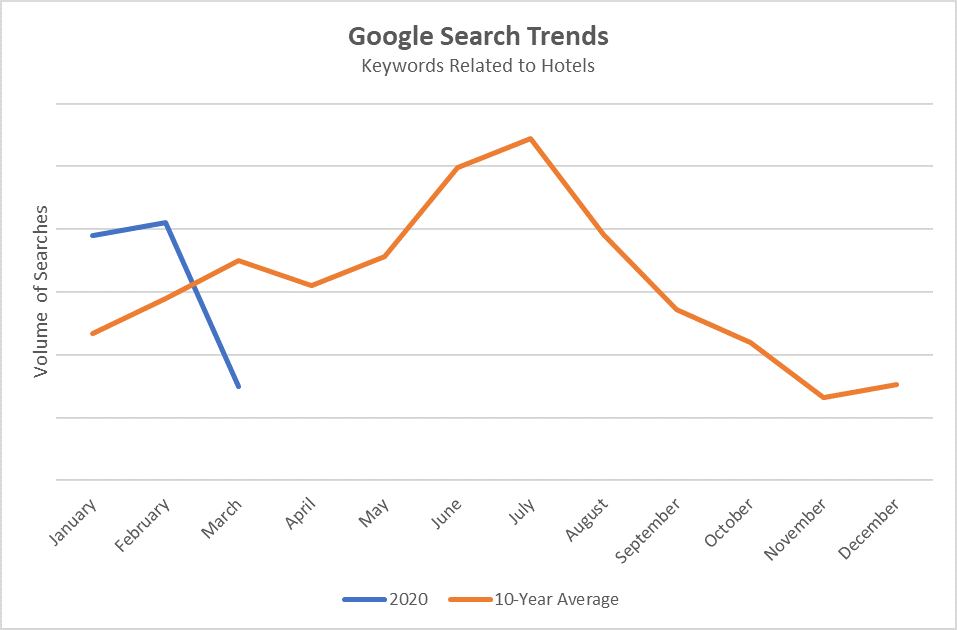
In March, for the first time we saw a decline in Hotel Google searches, down 24% compared to the 10-year average. Making this even more of a letdown, 2020 had previously been on pace to exceed the 10-year average, with searches in January and February tracking about 25% higher than in years’ past. And if you consider Google search activity to be a dependable indicator of consumer demand and intent, 2020 was looking promising.
With stay-at-home orders enacted, people had to quickly adapt and make the best of the situation by self-isolating, working remotely, streaming entertainment, playing video games, and connecting with friends and family online. As a result, social media usage exploded to the point where software engineers in Silicon Valley scrambled to keep their systems up and running and the lights on. This phenomenon was coined by influencers and insiders as ‘The Isolation Bump’:
- Impressions on Instagram campaigns jumped 22 percent in March.
- Engagement on the already surging TikTok platform increased 27 percent.
- Snapchat saw usage of augmented reality features jump 25% in March.
- Facebook messaging apps doubled in usage.
- Traffic to YouTube increased 22%.
The number of people consuming content online has been so intense, streaming platforms and internet service providers have considered capping video quality to meet the bandwidth needs. While the economy and hospitality industry has taken a hit, people are consuming content online more than ever before. This has included virtual tours, armchair travel experiences and research to populate post-virus bucket lists.
“Chaos isn’t a pit. Chaos is a ladder.”
When the initial lockdown plans were revealed, many marketers reactively pulled back ad buys. Consequently, Facebook and Google announced an expected $44 billion loss in ad revenue. Even with people cooped up spending more time than ever before on social media platforms, there exists a shortage of ad inventory, creating an interesting opportunity for marketers ready to capitalize on the unusual media landscape. Just like with gas prices dropping below $2 on average, costs to run social media advertising is less expensive, and with more people using the platform, the typical ad will reach more people at a lower cost.
For hospitality marketers these indicators present an interesting proposition. As the economy recovers, there will be early adopters planning trips in anticipation of the return to normal. In a recent survey, economists revealed speculation for a recovery to begin Q3, setting an approximate timeline for when hospitality marketers can expect these early adopters to arrive. In the meantime, with a gap in activity in Q2, resources can be committed to resetting social media marketing strategies, which may have been put on the back burner to chase short-term gains. In February, we posted an article outlining a helpful guide for strategy planning, called Hero, Hub, Hygiene. This best-practice framework was developed by Google and is a great place to start.
Additionally, with so many people cooped up, when the threat of the pandemic finally begins to fade, expect the appeal of the staycation to go the way of the Macarena. Recent Google research outlined the four stages of trip planning starts with a “I-want-to-get-away moment.” For those growing tired of life-at-home for a variety of reasons, the appeal of travel inspiration should pique.
Game of Thrones fans will recall the “chaos” quote from season three, and its wisdom to use a time of chaos to build a ladder out of the mess. Here’s is my recommendation for setting the objectives for the social media team:
- Take advantage of quarantine time to reset strategy and align cadence towards an economic recovery time in June/July.
- Focus messaging to plant seeds of inspiration for an “I-want-to-get-away-moment.”
- Ask followers to engage with nostalgic content to jump start booking behavior.
- Experiment, test, and learn with new social media ad types, and convert early-adopters while market is suppressed, and costs are low.
Learnings from the current social media landscape for the hospitality market
At the end of each quarter, we analyze 100 social media channels across the hospitality industry from boutique hotels, to large franchises, and online booking solutions. This analysis looks at the last 12 posts on Instagram and captures the amount engagement for each post against the channels following.
For Q4 2019, we found the industry benchmark engagement rate for hotel brands to be 1.37%. Interestingly, in Q1 2020, this only decreased marginally, 2.9% to 1.33%. The takeaway, there was very little, and almost no change despite the macro-factors.
Conversely, we found the median engagement rate increased 32%, indicating that more hotel brands were experiencing increased engagement on their Instagram channels. This means Instagram users are spreading the love and engaging with more content across different hotel brands, maybe even doing a little research and seeking travel inspiration.
To help planning and research, here are the power rankings for Top Hotel Brands on Instagram, ranked by overall performance:
Top 20 Hotel Brands on Instagram by Growth, Engagement Rate (Q4 2019 -Q1 2020)
1. Radisson | @radisson
2. Golden Crown – Levin Iglut | @leviniglut
3. Hilton Garden Inn | @hiltongardeninn
4. Hilton Rose Hall Resort & Spa | @hiltonrosehall
5. The Society Hotel | @societyhotel
6. Hilton Waikoloa Village | @hiltonwaikoloavillage
7. Pebble Beach Resorts | @pebblebeachresorts
8. Gleneagles Hotel | @thegleneagleshotel
9. Premier Inn | @premierinn
10. El Fenn Hotel Marrakech | @elfennmarrakech
11. Encore Boston Harbor | @encorebostonharbor
12. The Ritz-Carlton Jakarta | @ritzcarltonjakarta
13. Byblos Art Hotel Villa Amista | @byblos_art_hotel
14. Hotel Aire de Bardenas | @airedebardenas
15. UXUA Casa Hotel & Spa | @uxua
16. Hyatt Ziva Cancun | @hyattzivacancun
17. Sheraton Maui Resort & Spa | @sheratonmaui
18. The Plaza Hotel | @theplazahotel
19. La Quinta Resort & Club | @laquintaresort
20. Virgin Hotels | @virginhotels
In observing content on these channels, we noticed a few commonalities. Here are some of the top posts over the last 6 months and tactics that are working:
Influencer Generated Content
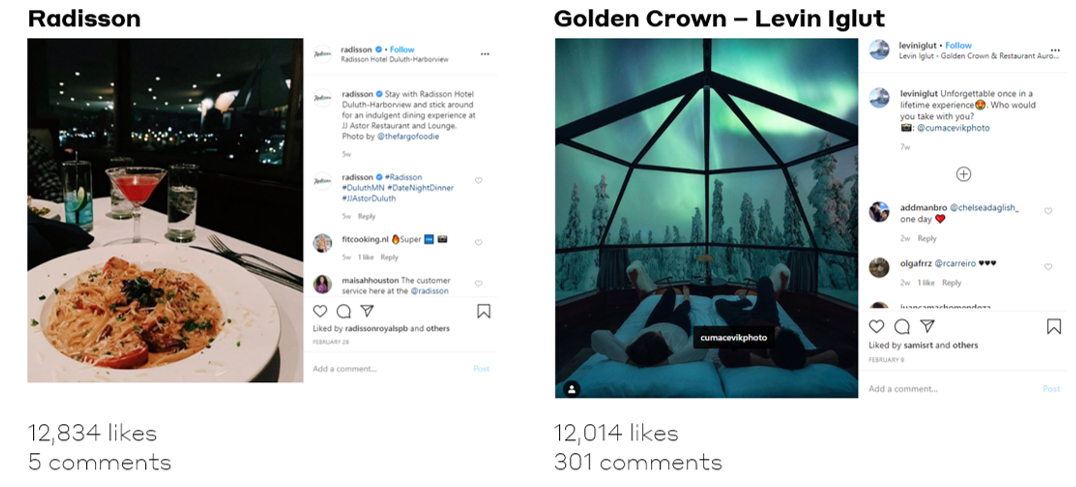
Many hotel brands have created simple influencer protocols to leverage user generated content. One top performer is Hilton. Their approach has helped the brand maintain multiple top performing channels. The Hilton process works like an integrated network where the individual hotel locations are enabled to utilize the process to leverage user generated content and occasionally feed into the parent brand channel, where the best of the best content is posted.
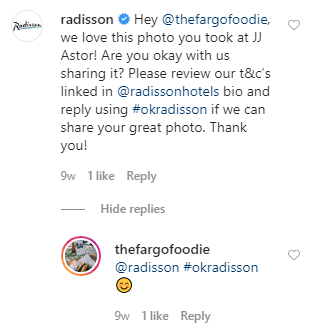
Radisson also has a simple influencer process, where content is found via geotagging. Radisson then reaches out to the creator to request permission via a response of #okradisson. By viewing this link, #okradisson, you can see all the content that is ready for use by Radisson and how effective this simple process is in filling the content pipeline. While the Radisson following is still small compared to large hotel brands, it has grown the most over the past few months and has a high engagement rate. Through their user generated content approach, Radisson has been able to curate nearly 3,000 pieces of content.
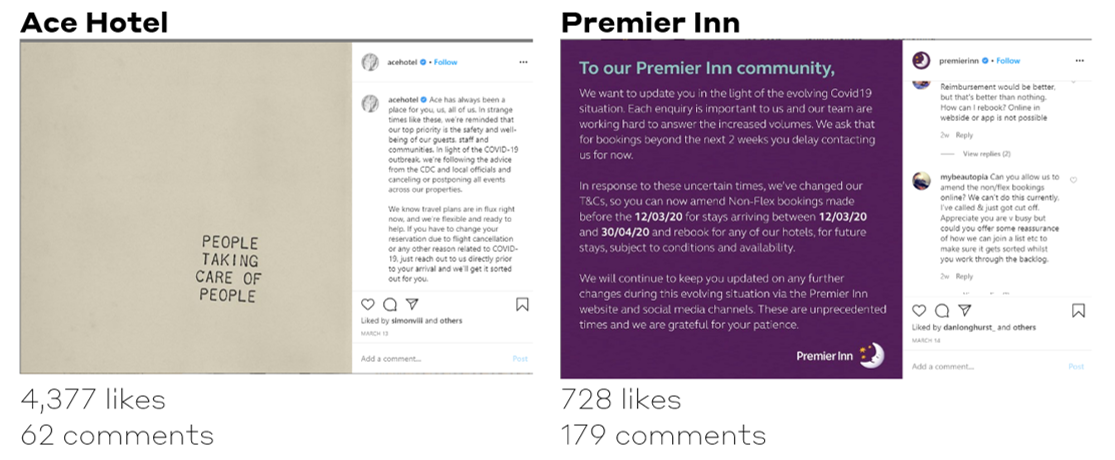
Some hotel brands have been proactive in their response to the pandemic crisis and the impact on their operations. In many cases, followers are empathetic in comments and share hope for a return to normal.
The Ace Hotel has a unique brand aesthetic with emphasis on artistic appeal. Although their post announced the cancellation of events across locations, many of their followers expressed support and a promise to be there when the doors reopen.
Premier Inn has been using social channels to communicate updates in real-time and going so far as to handle customer service issues one-to-one directly on their channels. In most cases, this honest and open approach has been greatly appreciated by their followers.
Planting Seeds of Inspiration and Nostalgia
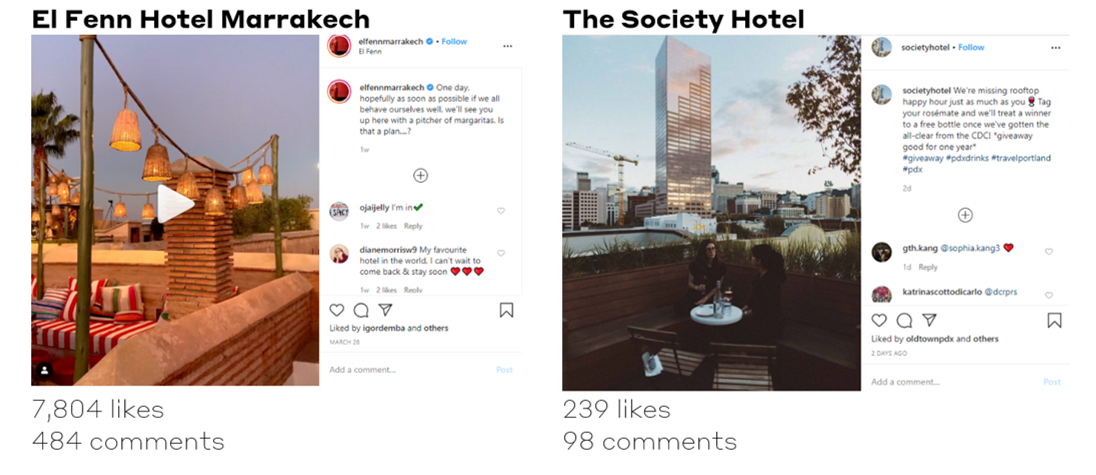
While some hotel brands are taking a break from social media, some are leaning in and setting the stage for a rendezvous with their followers.
El Fenn Hotel Marrakech has one of the most admirable social media presences and posted a heartfelt message that resonated with their followers, inspiring nearly 500 comments. Many commenters responded with confirmation of their desires to return or finally visit for the first time.
One day, hopefully as soon as possible if we all behave ourselves well, we’ll see you up here with a pitcher of margaritas. Is that a plan….?
The Society Hotel posted a similar sentiment with a clever promotional giveaway that is redeemable for up to a year. Followers were asked to tag a friend they’d like to share a bottle of wine with to enjoy when the rooftop bar finally reopens.
Maximizing Social Media ROI
Now with a lay of the land and inspiration, let’s get tactical. How can you ensure a good return on a marketing investment using social media? What’s the approach of the narrow path, understanding these dollars are critical funds that must succeed?
Start with Facebook Audience Insights
To help determine a creative direction and message, Facebook Insights offers a powerful shortcut. With this tool you can view demographic and compelling psychographic information to help paint a clearer picture of your target audience.
For instance, marketers can filter Facebook’s 2.45 billion users, by location, age and gender, then by interest. This taps into Facebook user behavior and allows you to better understand the likes and hobbies of a group. These audience groups can be saved and used in campaigns later. But the more intriguing prospect is using these dimensions to shape tactical decisions.
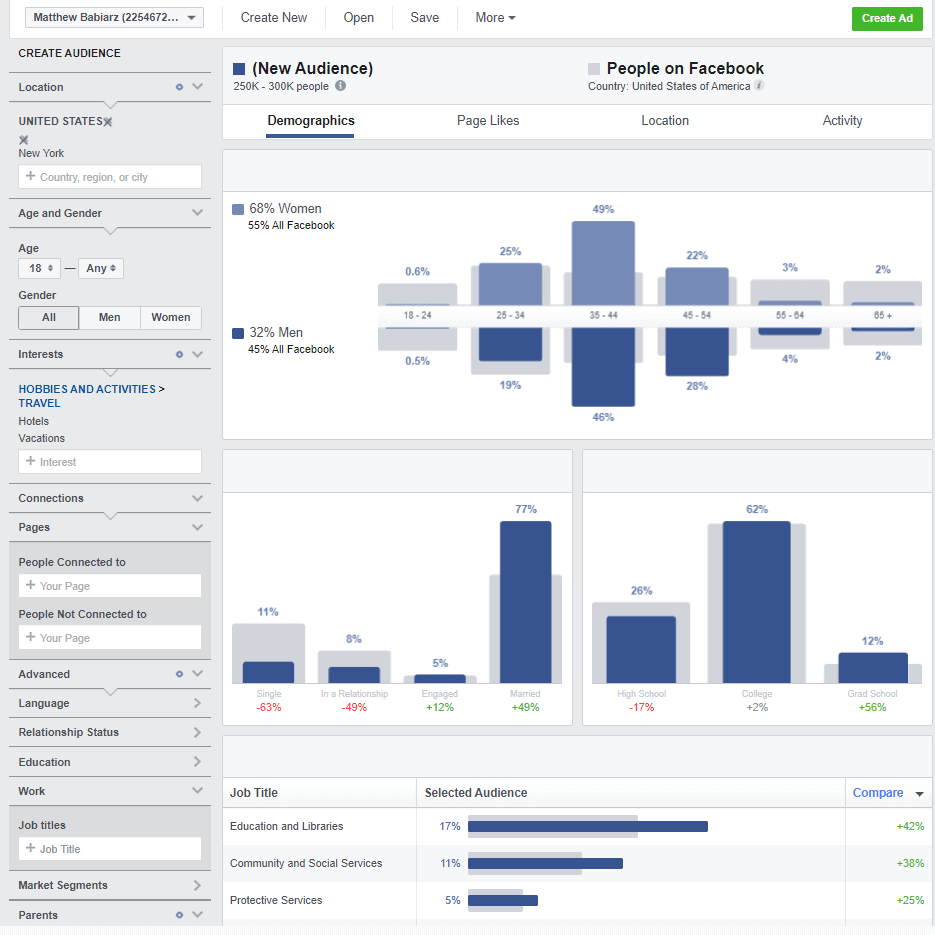
Over 700 million people are interested in travel and hotels on Facebook, but let’s say many of your hotel’s past visitors have come from New York State and you’re targeting families. Filtering by New York state, and then using the Parents filter to select parents of children ages 3-18 brings this target audience down to a more manageable 250k. You find that 68% are women and tend to work more than average in education and healthcare. Marketers can dive deeper utilizing the tabs at the top to see specific cities, but more importantly Page Likes and Activity. Tabbing to these dimensions reveal even more compelling opportunities. For example, our New York family group are 466x more likely to engage with local amusement parks. With this information you can prioritize proximity to similar attractions in your messaging. The Activity tab reveals that 66% of this audience uses mobile-only and are twice as likely to click on ads than the average Facebook user.
Armed with this information, we know we want to run a mobile-friendly ad targeting New York State, that focuses on proximity to amusement park attractions, with creative that features families and moms that may work in education/healthcare. This placement should give the ad campaign the best possible chance of maximizing a return as we’re tapping into the prospective guests’ interest.
Now that we understand our target audience, what can we do to take it to the next-level and even further ensure a successful campaign, understanding that this is a mobile-only Facebook audience programming ad with Facebook Instant Experiences?
Utilize Facebook Instant Experiences
Facebook Instant Experiences are an option on Facebook and Instagram campaigns that enable a mobile-friendly web-like user experience that lives natively within the Facebook/Instagram apps. This essentially works as a mobile-friendly landing page that loads up to 15 times faster than what a user would experience in a mobile browser. Facebook offers several templates to construct a uniquely branded experience, with layouts and features that align to different goals along the sales funnel.
Facebook Instant Experiences are the perfect click-thru for a Facebook ad campaigns, as they drive conversion faster by avoiding the drop-off that occurs when people leave Facebook for a landing page. By using these two critical tactics within your hotel brand’s campaign you can experience results like these travel brands:
- Celebrity Cruises campaign drove a 23X return on ad spend, while seeing their cost per click decrease 23%
- AirBnB saw a 3X increase in return on spend and 43% reduction in customer acquisition cost
- Trentino Marketing saw a 4.23X increase is offers viewed and 18% more organic traffic to their website.
Additionally, Facebook Instant Experiences allow for powerful retargeting options, allowing you to run ads on members of your target audience that viewed a Facebook Instant Experience but didn’t convert, without requiring any technical setup.
We Will See It Through
Although many have put their travel plans on hold, those plans are not forgotten. While stuck indoors and online, wanderlust has continued to grow. With increased activity on social media platforms, people are seeking inspiration anticipating their chance to escape. While operations may have slowed down, now is the perfect time to refine your content strategy approach. If you move quickly enough, there may be an opportunity to amplify your content through paid social media while the costs are still low. Just a few reasons to remain cautiously optimistic on what lies ahead.
Stay safe, stay healthy.
